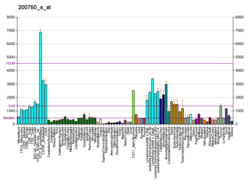Ran (タンパク質)
Ran(RAs-related Nuclear protein)は、ヒトではRAN遺伝子にコードされるタンパク質である。Ranは約25kDaのタンパク質で、間期中の細胞核内外の輸送に関与し、有糸分裂にも関与する。Rasスーパーファミリーのメンバーである[5][6][7]。
Ranは、RNAとタンパク質が核膜孔複合体を通って輸送される際に必要な低分子量Gタンパク質である。また、Ranの変異によってDNA合成が妨げられることから、RanがDNA合成や細胞周期の進行の制御に関与していることも示唆されている[8]。
機能
[編集]Ranサイクル
[編集]
細胞内でRanは、GDP結合型とGTP結合型という2種類のヌクレオチド結合状態で存在する。Ranに対するグアニンヌクレオチド交換因子であるRCC1の作用によって、GDP結合型Ran(RanGDP)はGTP結合型Ran(RanGTP)へと変換される。RCC1はRanGEFという名称でも知られている。Ranの内在的なGTPアーゼ活性は、RanGTPアーゼ活性化タンパク質(RanGAP)との相互作用によって活性化され、Ran結合タンパク質(RanBP)との複合体形成によって促進される。GTPアーゼの活性化によってRanGTPはRanGDPへ変換され、Ranサイクルが閉じられる。
Ranは細胞内を自由に拡散するものの、RCC1とRanGAPは細胞内の異なる場所に局在しているため、RanGTPとRanGDPの濃度も局所的に異なることとなり、他の細胞過程のためのシグナルとして機能する濃度勾配が作り出される。RCC1はクロマチンに結合しているため、核内に局在する。RanGAPは酵母では細胞質に位置し、植物や動物では核膜に結合している。動物細胞では、RanGAPはSUMO修飾がなされ、ヌクレオポリンNup358(RanBP2)との相互作用を介して核膜孔複合体の細胞質側に結合している。このようなRanサイクル補助タンパク質の局在部位の違いによって、RanGTPのRanGDPに対する比率は細胞核の内側で高く、逆に細胞核の外側では低くなる。Ranのヌクレオチド結合状態の勾配に加えて、タンパク質自身の濃度勾配も存在し、Ranは細胞質よりも核内で高濃度である。細胞質のRanGDPはNTF2(Nuclear Transport Factor 2)によって核内へ輸送され、そこでRCC1によってGDPからGTPへの交換が触媒される。
間期中の核輸送における役割
[編集]
Ranはカリオフェリンと相互作用し、それらの積み荷分子を結合・解離する能力を変化させることで、核膜を越えたタンパク質輸送に関与する。核局在化シグナルを含む積み荷タンパク質はインポーチンに結合し、核へ輸送される。核内ではRanGTPがインポーチンに結合し、輸入された積み荷を解離する。核を出て細胞質へ輸送される必要のある積み荷はエクスポーチンに結合し、RanGTPと三者複合体を形成する。核外でのRanGTPからRanGDPへの加水分解によって、複合体は解離し、輸出された積み荷は放出される。
有糸分裂における役割
[編集]有糸分裂の間、Ranサイクルは紡錘体の組み立て、そして染色体分離後の核膜の再形成に関与している[9][10]。前期の間、核膜は漏れやすい構造となったり解体されたりするため、核膜孔でのRanGTP-RanGDPの比率の急な勾配は崩壊する。グアニンヌクレオチド交換因子であるRCC1はクロマチンに結合したままであるため、染色体周辺のRanGTPの濃度は高いままである[11]。RanBP2(Nup358)とRanGAPはキネトコアへ移動し、紡錘糸の染色体への接着を促進する。さらに、RanGTPは核輸送機構と類似した機構で紡錘体の組み立てを促進する。NuMAやTPX2といった紡錘体の組み立てに関与する因子の活性はインポーチンの結合によって阻害されている。RanGTPはインポーチンを解離させることで、これらの因子を活性化し紡錘体の組み立てを促進する。終期における娘細胞での核膜再形成時の小胞融合には、RanGTPの加水分解とヌクレオチド交換が必要とされる。
Ranとアンドロゲン受容体
[編集]Ranはアンドロゲン受容体(AR)のコアクチベーター(ARA24)であり、AR内部のポリグルタミン配列の長さによって異なる結合を示す。ARのポリグルタミンリピートの伸長は球脊髄性筋萎縮症と関連している。AR内のポリグルタミンが伸長するにつれてRANのコアクチベーターとしての機能は消失し、それによって球脊髄性筋萎縮症発症時の部分的なアンドロゲン不応性がもたらされている可能性がある[12][13]。
調節
[編集]Ranの発現はマイクロRNAmiR-10aによって抑制される[14]。
相互作用
[編集]Ranは次に挙げる因子と相互作用することが示されている。
出典
[編集]- ^ a b c GRCh38: Ensembl release 89: ENSG00000132341 - Ensembl, May 2017
- ^ a b c GRCm38: Ensembl release 89: ENSMUSG00000029430 - Ensembl, May 2017
- ^ Human PubMed Reference:
- ^ Mouse PubMed Reference:
- ^ “A G protein involved in nucleocytoplasmic transport: the role of Ran”. Trends Biochem. Sci. 19 (5): 211–6. (May 1994). doi:10.1016/0968-0004(94)90024-8. PMID 7519373.
- ^ “Ran, a GTPase involved in nuclear processes: its regulators and effectors”. J. Cell Sci. 109 (10): 2423–7. (October 1996). PMID 8923203.
- ^ “Nuclear transport: run by Ran?”. Am. J. Hum. Genet. 63 (2): 311–6. (August 1998). doi:10.1086/301990. PMC 1377330. PMID 9683621.
- ^ “The ran decathlon: multiple roles of Ran”. J. Cell Sci. 113 (7): 1111–8. (April 2000). PMID 10704362.
- ^ “The mechanism of spindle assembly: functions of Ran and its target TPX2”. J. Cell Biol. 166 (7): 949–55. (September 2004). doi:10.1083/jcb.200312112. PMC 2172015. PMID 15452138.
- ^ “Spatial control of mitosis by the GTPase Ran”. Cell. Mol. Life Sci. 64 (15): 1891–914. (August 2007). doi:10.1007/s00018-007-6568-2. PMID 17483873.
- ^ “Generation of GTP-bound Ran by RCC1 is required for chromatin-induced mitotic spindle formation”. Nature 400 (6740): 178–81. (July 1999). Bibcode: 1999Natur.400..178C. doi:10.1038/22133. PMID 10408446.
- ^ “The linkage of Kennedy's neuron disease to ARA24, the first identified androgen receptor polyglutamine region-associated coactivator”. J. Biol. Chem. 274 (29): 20229–34. (July 1999). doi:10.1074/jbc.274.29.20229. PMID 10400640.
- ^ “Identification and characterization of androgen receptor associated coregulators in prostate cancer cells”. J. Biol. Regul. Homeost. Agents 15 (2): 123–9. (2001). PMID 11501969.
- ^ “MicroRNA-10a binds the 5'UTR of ribosomal protein mRNAs and enhances their translation”. Mol Cell 30 (4): 460–71. (2008). doi:10.1016/j.molcel.2008.05.001. PMID 18498749.
- ^ a b c “Facilitated nucleocytoplasmic shuttling of the Ran binding protein RanBP1”. Mol. Cell. Biol. 20 (10): 3510–21. (2000). doi:10.1128/MCB.20.10.3510-3521.2000. PMC 85643. PMID 10779340.
- ^ “Dominant-negative mutants of importin-beta block multiple pathways of import and export through the nuclear pore complex”. EMBO J. 16 (6): 1153–63. (1997). doi:10.1093/emboj/16.6.1153. PMC 1169714. PMID 9135132.
- ^ “Molecular interactions between the importin alpha/beta heterodimer and proteins involved in vertebrate nuclear protein import”. J. Mol. Biol. 266 (4): 722–32. (1997). doi:10.1006/jmbi.1996.0801. PMID 9102465.
- ^ “Nercc1, a mammalian NIMA-family kinase, binds the Ran GTPase and regulates mitotic progression”. Genes Dev. 16 (13): 1640–58. (2002). doi:10.1101/gad.972202. PMC 186374. PMID 12101123.
- ^ “Computational and biochemical identification of a nuclear pore complex binding site on the nuclear transport carrier NTF2”. J. Mol. Biol. 344 (2): 303–10. (2004). doi:10.1016/j.jmb.2004.09.043. PMID 15522285.
- ^ “Structural basis for molecular recognition between nuclear transport factor 2 (NTF2) and the GDP-bound form of the Ras-family GTPase Ran”. J. Mol. Biol. 277 (3): 635–46. (1998). doi:10.1006/jmbi.1997.1602. PMID 9533885.
- ^ a b “The mammalian Mog1 protein is a guanine nucleotide release factor for Ran”. J. Biol. Chem. 275 (30): 23175–80. (2000). doi:10.1074/jbc.C000252200. PMID 10811801.
- ^ a b “Separate domains of the Ran GTPase interact with different factors to regulate nuclear protein import and RNA processing”. Mol. Cell. Biol. 15 (4): 2117–24. (1995). doi:10.1128/MCB.15.4.2117. PMC 230439. PMID 7891706.
- ^ “The crystal structure of rna1p: a new fold for a GTPase-activating protein”. Mol. Cell 3 (6): 781–91. (1999). doi:10.1016/S1097-2765(01)80010-1. PMID 10394366.
- ^ “RNA1 encodes a GTPase-activating protein specific for Gsp1p, the Ran/TC4 homologue of Saccharomyces cerevisiae”. J. Biol. Chem. 270 (20): 11860–5. (1995). doi:10.1074/jbc.270.20.11860. PMID 7744835.
- ^ “RanGAP1 induces GTPase activity of nuclear Ras-related Ran”. Proc. Natl. Acad. Sci. U.S.A. 91 (7): 2587–91. (1994). Bibcode: 1994PNAS...91.2587B. doi:10.1073/pnas.91.7.2587. PMC 43414. PMID 8146159.
- ^ “Structural basis for guanine nucleotide exchange on Ran by the regulator of chromosome condensation (RCC1)”. Cell 105 (2): 245–55. (2001). doi:10.1016/S0092-8674(01)00315-4. PMID 11336674.
- ^ “Model of the ran-RCC1 interaction using biochemical and docking experiments”. J. Mol. Biol. 289 (4): 1119–30. (1999). doi:10.1006/jmbi.1999.2820. PMID 10369786.
- ^ “Structure of the nuclear transport complex karyopherin-beta2-Ran x GppNHp”. Nature 399 (6733): 230–7. (1999). Bibcode: 1999Natur.399..230C. doi:10.1038/20375. PMID 10353245.
- ^ a b “Karyopherin beta 2B participates in mRNA export from the nucleus”. Proc. Natl. Acad. Sci. U.S.A. 99 (22): 14195–9. (2002). Bibcode: 2002PNAS...9914195S. doi:10.1073/pnas.212518199. PMC 137860. PMID 12384575.
- ^ “The coiled coil region (amino acids 129-250) of the tumor suppressor protein adenomatous polyposis coli (APC). Its structure and its interaction with chromosome maintenance region 1 (Crm-1)”. J. Biol. Chem. 277 (35): 32332–8. (2002). doi:10.1074/jbc.M203990200. PMID 12070164.
- ^ “CRM1 is an export receptor for leucine-rich nuclear export signals”. Cell 90 (6): 1051–60. (1997). doi:10.1016/S0092-8674(00)80371-2. PMID 9323133.
- ^ “Exportin-5, a novel karyopherin, mediates nuclear export of double-stranded RNA binding proteins”. J. Cell Biol. 156 (1): 53–64. (2002). doi:10.1083/jcb.200110082. PMC 2173575. PMID 11777942.
関連項目
[編集]外部リンク
[編集]- ran GTP-Binding Protein - MeSH・アメリカ国立医学図書館・生命科学用語シソーラス
- Patel SS. “Animations of nuclear transport factors, including Ran (1 of 2 pages)”. Nuclear Transport Animations. 2008年6月12日閲覧。
- Patel SS. “Animations of nuclear transport factors, including Ran (2 of 2 pages)”. Nuclear Transport Animations. 2008年6月12日閲覧。







